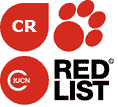Anolis utilensis (KÖHLER, 1996)
Find more photos by Google images search: ![]()
| Higher Taxa | Anolidae, Iguania, Sauria, Squamata (lizards) |
| Subspecies | |
| Common Names | E: Utila Anole |
| Synonym | Norops utilensis KÖHLER 1996 Norops utilensis — KÖHLER 2000: 64 Norops utilensis — NICHOLSON 2002 Anolis utilensis — POWELL 2003: 38 Norops utilensis — NICHOLSON et al. 2012 Norops utilensis — MCCRANIE & KÖHLER 2015: 196 |
| Distribution | Honduras (Islas de la Bahia: Utila) Type locality: Islas de la Bahia: Utila, Honduras. |
| Reproduction | oviparous |
| Types | Holotype: SMF 77051, Adult male; paratypes: SMF, UNAH |
| Diagnosis | Diagnosis: A medium-sized (snout-vent length 59 mm in largest specimen), short-legged Norops, with transverse processes on some autotomous caudal vertebrae, white fungus-like markings are present on a gray dorsum. The dewlap is red and mouth and throat lining black. It can be distinguished from all other beta anoles (= Norops), except those of the pentaprion group, by the following combination of characters: all scales smooth, except on tail where they are strongly keeled; middorsal caudal scales not raised in serrated crest; upper trunk with flat granules disposed in oblique rows, except for about a dozen longitudinal rows on middorsum; belly with conical granules, slightly larger than dorsals. Dorsal head scales relatively large, frontal ridges weak, canthal ridges present; elongated supraciliary scales absent; 4-5 horizontal loreal rows; suboculars in contact with supralabials; no enlarged postanal scales. The granular instead of lamellar proximal subdigitals (under phalanx ii) (Fig. 3) immediately distinguishes Norops utilensis n. sp. from the remaining species in the pentaprion group. In addition, N. utilensis can be further distinguished from its close relative N. pentaprion by a greater tail length / SVL ratio (1.47-1.64, x = 1.55 in 7 utilensis vs. 1.05-1.42, x = 1.26 in 27 pentaprion) and the number of scales between the supraorbital semicircles (0 in utilensis und usually 1, rarely 0, in pentaprion). The strongly carinate scales on top of the tail, 0 instead of 2 scales between supraorbital semicircles, and the absence of bony parietal protuberances will separate the species from N. fungosus. From N. sulcifrons it differs further by having a black instead of an unpigmented throat lining and by the number of supralabials to center of eye (7-9 in utilensis vs. 6-7 in sulcifrons). From N. vociferans it can be distinguished by having smooth mid-dorsal granules (some mid-dorsal granules keeled in vociferans), the absence of a dark interorbital bar, and the absence of enlarged postanal scales in males. From N. ortonii it differs by having smooth instead of feebly keeled dorsals, granular instead of imbricate ventrals, and the absence of a dark interorbital bar. From N. ibague it can be distinguished by one scale between interparietal and supraorbital semicircles (in contact in N. ibague), one scale between nasal and rostral, and granular instead of imbricate ventrals. |
| Comment | Belongs to the pentaprion group which includes seven species: fungosus, ibague, ortonii, pentaprion, sulcifrons, utilensis, and vociferans. Synonymy: Poe considers the diagnostic characters suggested by Köhler as insufficient to distinguish between A. beckeri and utilensis (Poe 2016). For instance, “the purported diagnostic traits of A. utilensis have changed over time (compare the original diagnosis of A. utilensis ; G. Köhler. 1996. Senckenbergiana Biologica 76:19–28) to that of this volume and the authors note that some individuals they assign to A. zeus lack the single diagnostic trait of the species (p. 98) (Poe 2016). Not listed by Nicholson et al. 2018. Species group: Norops auratus Species Group (fide Nicholson et al. 2012) Abundance: only known from the type locality (Meiri et al. 2017). |
| Etymology | Named after the type locality. |
| References |
|
| External links |


